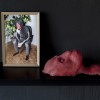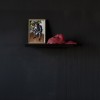In the last years there have been two monkeys with a lively presence on the Polish Internet: the proboscis monkey (nascalis larvatus, or the long-nosed monkey) and the bald uakari (cacajao calvus).
The proboscis monkey is a disappearing species living in Borneo whose numbers have been dramatically decreasing due to cutting down forests for palm oil plantations. Since 2016, the proboscis monkey has been the hero of an enormous number of memes in which he appears as Janusz – a typical Pole. He has a huge nose and his posture is deceptively similar to one resulting from many years of drinking beer in front of TV; thus, he fits perfectly as the representative of a stereotypical Pole, mocking, and yet avuncular in his predictable Polishness.
The creation of the topos of Janusz the Proboscis Monkey has resulted in matching other monkey species to the nationalities of our European neighbours. The most common among them has become the Bald Uakari, a small monkey living in the Amazon, which, as a meme, has transformed into “a typical Ukrainian”. The blood-red face of the Uakari has become the face of “a constantly drunk Ukrainian”. The identity of both monkeys is thus closely connected with alcohol and alcoholism, but the way it is served differs significantly.
Interestingly, in Indonesian the proboscis monkey is known as monyet belanda (the Dutch monkey) or orang belanda (Dutchman), as in the times of colonization indigenous Indonesians had noticed that the Dutch colonizers are deceptively similar to the proboscis monkey due to their large bellies and noses. In turn, the word Uakari was created by the indigenous people of the Amazon and it meant the exact same thing: a Dutchman. The monkeys started to be called by this name, because their red faces reminded the local population those of the European colonizers, burnt in the sun.
Although the proboscis monkey and the uakari live in different continents, they represent the history of colonization, transformative for the indigenous peoples of the areas they come from.
The two monkeys present in countless Polish memes, copypastas and hashtags are dancing around each other a dance of non/brotherhood, dis/similarity, strangeness, mutual positioning and the need for superiority. Their story is shown from the point of view of a place where emotions are presented in an extreme and unfiltered way, that is, the Internet space; it also brings to mind the suggestion extended by Professor Maria Janion – to perceive Poland as a country that is both a colonizer and colonized.






